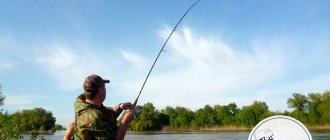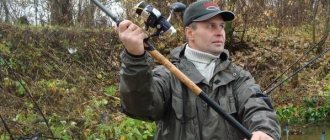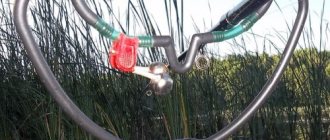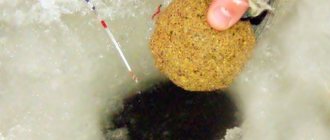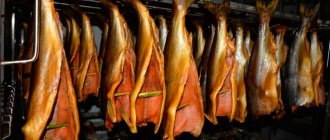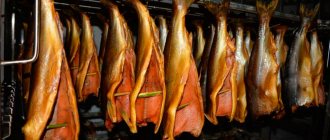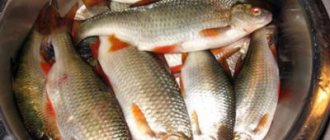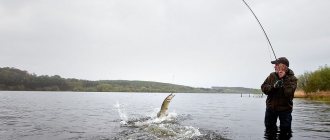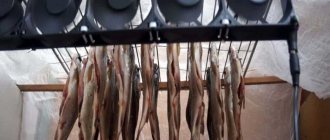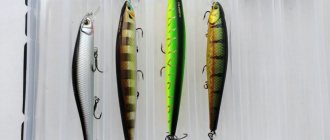One of the burning questions is how to properly hook fish on the feeder. Beginner feeders often have difficulty getting bites. Transferring experience from conventional fishing with donks does not work here - the feeder is a different tackle with a specific fishing technique. In this article we will analyze in detail the nuances of biting, hooking and fishing on feeder tackle.
Equipment Features
When fishing is successful, there are no difficulties. The quivertip twitches, moves to the side - and the fisherman takes the fish out of the reservoir. However, in feeder fishing there are many special moments, failure to comply with which leads to unrealized bites, broken leads or the disappearance of fish at the beginning of fishing. The technique for biting and retrieving is based on the features of the feeder equipment and depends on the nuances of installation, fishing conditions and fish behavior. It is impossible to take all these factors into account in theory. The system develops for each fisherman individually in the process of gaining experience. Here we will look at obvious points that will help novice feeders and, perhaps, add something to the knowledge of experienced fishermen. Read more about feeder equipment.
What to do with bait if the feeder doesn’t bite?
Even when bait is already involved in the process of feeder fishing, you can change its aromatic, mechanical or other properties. Often in summer, due to the heat, the aromatic properties of feeder bait may deteriorate. The aroma from the bait disappears under the influence of temperature. Therefore, it makes sense to add an additional portion of flavoring to the bait. Peaceful fish in the search for food, in the overwhelming majority of cases, rely on their sense of smell.
The second option to attract fish is to make the bait gather dust. To do this, part of the bait can be mixed with dry soil, or you can even send several feeders filled only with soil into the water. Often this technique leads to bites. Moreover, it is not clear: either the fish are attracted by the dregs from the soil, or whether they are attracted by the natural smell of the soil.
The third option is to fill the feeder with only the large fraction, for example, steamed pearl barley or wheat. But it is important not to get a very viscous consistency. In order to avoid increased viscosity, pearl barley can be mixed with some of the dry soil.
Bite on the feeder - when to hook
Under different conditions, the bite is expressed in a certain behavior of the quivertype. The standard is a few short pokes and a pull with an amplitude of 5-15 cm. This is a classic bite, followed by hooking and fishing. However, in practice it is not so simple. The behavior of the fish and the variety of conditions introduce an element of unpredictability into the technique of working with fishing tackle.
Factors influencing the display of a bite with the tip of the feeder:
- Feeder equipment (monoline or cord, type of installation, leash length, hook and nozzle size);
- Fishing conditions – distance to the point, current strength, depth;
- Fish behavior.
Depending on the combination of these factors, the bite on the feeder and further sale by the fisherman occurs in different ways.
- A slight trembling, a shotgun without continuation indicates a small fish biting.
- Measured pokes of the tip of the feeder and subsequent pulling are a classic, a normal bite.
- Stretching without poking.
- Crazy dances of the quivertype, indicating self-notching.
Due to the design features of the feeder, the heaviness of the feeder and the long fishing range, self-notching is a common thing for a feeder. During fishing, the angler actively regulates this moment. When the bites start, you need to choose the length of the leash. For idle bites and early escapes, we shorten the leash, and for deep swallowing, lengthen it. In general, we change the equipment so that it starts working effectively, in accordance with the fishing pace. You may need to install larger hooks or, on the contrary, smaller ones. Learn more about feeder fishing techniques.
Idle bites
The first signal to change something is normal bites (obviously not a small thing), but the absence of effective hooks. Possible treatments:
- Changing the length of the leash, stretching the feeder;
- Changing the installation to a different one in principle;
- Changing the hook size;
- Experiments with bait - methods, quantity, method of baiting;
- Hooking options - sometimes you need to wait, in other cases - react to the first poke;
- Changing the position of the rod. It was against the flow - we install it the other way around, at an angle or more vertically.
Working with these moments is an obligatory part of the feeder technique for the implementation of hooking. There are bites, which means the fish have gathered. All that remains is to correctly build a system for working with the feeder and start successfully cutting.
How to hook fish correctly
8 minutes Author: Andrey Goryachev 168
Hooking is a very important action, on which the final result of fishing often depends. By learning how to hook fish correctly, an angler can significantly increase the weight of his catch.
When fishing with a float rod
It can be quite difficult for a novice fisherman to master the hooking technique and wait for the right moment to hook when fishing with a float rod. This is due to excessive emotions when biting and a great desire to pull the bitten fish ashore.
Choosing the right moment to hook is also complicated by the fact that each type of fish has its own bite pattern - this requires an individual approach to hooking.
Technique
If an angler has learned to cope with his emotions, then mastering the hooking technique when fishing with float tackle is quite simple. When fishing with a fly rod, the hook is a short and sharp jerk, the amplitude of which is about 15–20 cm. This movement will be quite enough for the sharp hook to pierce the soft tissues of the fish’s oral cavity and securely hold it while fishing.
A short hook is also good because it allows you to avoid re-casting the rig. If the fish is not caught, then after free hooking the equipment can not be re-cast, but left at the fishing point. This technique allows you to increase the pace of fishing. It is important to remember that this action is effective only when fishing on animals and hard plant baits. If a “chatterbox” or dough is used as bait, they will fly off the hook at the first sharp movement of the rod.
Beginner fishermen often make the mistake of making too vigorous and sweeping movements with the rod when biting, which can lead to the following unpleasant consequences:
- breakage of the leash;
- fish lip rupture;
- tangling of equipment;
- rod breakage.
Such troubles more often occur if the fisherman has chosen a fast-action sports rod for fishing, which has an excessively stiff whip. In this regard, it should be noted that an inexperienced angler should give preference to softer fishing rods, which allow some mistakes to be made when hooking.
Hooking is carried out in a completely different way when fishing with Bolognese and match gear. The fact is that when fishing at a long distance, the wind or current puts constant pressure on the fishing line. As a result of such pressure, the monofilament goes to the float not directly, but in an arc. The resulting arc often interferes with making a quality hook. In addition, a long piece of monofilament fishing line has a high elongation coefficient, which also complicates the cutting process. In order to reliably hook a fish when fishing at a long distance, the angler needs to make a sweeping movement with the rod, which will allow him to select the formed arc and neutralize the shock-absorbing qualities of the fishing line.
Choosing the right moment
In addition to the hooking technique, the fisherman must learn to understand at what point he needs to hook. In this matter, much depends on the following factors:
- type of fish;
- type of nozzle;
- fish activity.
- correct loading of the float.
It can be very difficult for an inexperienced fisherman to decide on the hook when fishing for a fish such as crucian carp. When fishing for crucian carp, the float can “squat” for a long time and move slightly from side to side. If you hook at this moment, then most likely the fish will not be detected. When fishing for crucian carp, the fisherman should be patient and wait until the float quickly moves to the side and begins to sink.
The tench bite deserves special attention. This fish can stare at the bait for several minutes. At this time, the bite alarm “squats” barely noticeably. You should only hook when the float antenna disappears under the water.
Bream also likes to taste the bait for a long time. If he likes the bait, he pulls it into his mouth, creating a directed flow of water, while the angler sees this action as the rise of a float. The hook should be carried out at this very moment.
Roaches usually feed above the bottom, so their bites look more aggressive. As a rule, the roach immediately drowns the bite alarm, which requires immediate hooking.
The bites on the perch float are also very expressive. Usually the float suddenly goes under water. You need to hook the predator immediately so that it does not have time to swallow the bait deeply.
The choice of when to hook depends largely on the type of nozzle used. If a worm is used as bait, then you should not rush into hooking. It is necessary to give the fish some time so that it can completely swallow the large bait. The fish usually swallows smaller baits right away, so you need to hook them a little earlier.
To perform a timely hook, the angler must also focus on the activity of the fish. If the fish is inactive, then during the entire fishing trip you may not see a normal bite, however, every time you pull out the equipment, you discover that the bait has been eaten. In this case, you need to hook at the first vibrations of the float.
The success of hooking greatly depends on the correct loading of the float. The bite alarm should be immersed in such a way that only a small part of its antenna remains on the surface of the water. If not only the antenna remains on the surface, but also part of the main body of the float, then the fish will feel the resistance of the equipment and will be able to pull the bait off the hook with impunity.
Particular attention should be paid to the sharpness of the hook. Many anglers make the mistake of trying to fish with one hook throughout the season. Modern hooks are very sharp, but they dull quite quickly, especially if fishing takes place in a reservoir with rocky soil. A dull hook makes reliable hooking impossible, so this piece of equipment must be replaced with a new one after 4-5 active fishing trips.
Nuances when fishing with feeder tackle
Feeder gear also requires the angler to understand the correct moment to hook. Feeder bites can vary greatly depending on several factors;
- the size of the pecking fish;
- the type of reservoir where fishing takes place;
- construction of equipment.
If we are talking about catching small fish, the bites of which often look like a small trembling of the quiver tip, then you should hook at the first movement of the tip of the feeder. When an angler aims to catch a large fish, he should not pay attention to the frequent jerks of small fish. Hooking should only be done when the quiver tip bends sharply.
The nature of the bite largely depends on the type of reservoir where fishing is carried out. During the current, the fish takes the bait more aggressively than in still water. This fact must be taken into account in order to carry out timely cutting.
The structure of the rig also affects the nature of the bite. Some types of feeder rigs are mounted in such a way that the angler does not need to hook at all. For example, equipment called “method” ensures reliable self-hooking of pecked fish.
When hooking on a feeder tackle, it is necessary to take into account the type of monofilament used. If the rig uses a braided cord, then the movement of the rod should be short and have an amplitude of 20–30 cm. This is due to the fact that the “braided line” has an elongation coefficient close to zero, so a hook that is too wide can result in the leader breaking. If monofilament fishing line is used as the main monofilament, then the risk of the leader breaking is significantly reduced and the hooking can be more sweeping.
On the donk
A bite indicator in bottom gear is usually a bell, which can indicate a bite not only visually, but also notify the fisherman with its ringing. The first stage of a donk bite looks like a slight trembling of a bell. At this moment, the underwater inhabitants are just tasting the bait, so the fisherman needs to refrain from hooking. It is necessary to hook at the next stage, when the line begins to tighten sharply or, conversely, weakens.
For spinning
The nature of the hook when fishing with a spinning rod depends on the type of bait chosen and the type of fish that is intended to be caught. When fishing with spinners, wobblers and “inedible” rubber, you need to make a detecting movement with a spinning rod at the first suspicion of a bite, since, sensing a catch, the predator instantly spits out the bait. If the angler uses “edible” rubber as bait, which includes aromatic oils and flavoring additives, then you can take your time with hooking and give the predator the opportunity to swallow the bait deeper.
Pike and pike perch have a hard, bony mouth that can only be penetrated with a strong, sweeping hook. Chub and asp are distinguished by their fleshy lips, so when fishing for these predators, too vigorous hooking is not required.
For winter gear
In ice fishing, hooking plays just as important a role as in open water fishing. When fishing with jigs and floats, the fish should be hooked very carefully, which is due to the use of thin fishing lines in winter. The hook should be a short and sharp movement of the hand. If the angler makes a more sweeping movement with his hand, then if a large fish bites, breaking the line will become inevitable.
When fishing for perch in shallow water, the hook should also be short, which will protect the tackle from breaking. When fishing for pike perch at great depths, you need to hook more widely, this is due to the stretchability of the monofilament line and the very hard mouth of the predator.
Hooking pike during winter fishing with girders deserves special attention. Only by learning how to hook a pike correctly can you count on the effectiveness of the jig tackle. Having noticed a bite and approaching the bait, the fisherman should immediately pay attention to the condition of the bait reel. If the line quickly leaves the reel, then the hook should be done immediately.
If the monofilament comes off the reel slowly, you need to wait a little while the pike swallows the bait more deeply and speeds up its pace. If the line does not unwind at all, then you should not hook at all. To begin with, you need to slowly pick up the slack and, only after feeling the resistance of the predator, strike. Hooking a pike onto a jig tackle is a sharp movement of the forearm.
Proper hooking is one of the most important components of successful fishing. If an angler knows how to hook a fish correctly and in a timely manner, he will be able to avoid the unfortunate loss of the trophy.
Sweeping
A special feature of the feeder fishing technique is specific hooking. Or rather, absence in most cases (when using the cord as the main fishing line). The usual hooking (jerk) on the donkey is performed only on monofilament. Thin leashes are often used on the feeder. Given the general rigidity, due to the inextensible cord, a sharp jerk can break the leash even on a 200-gram roach. In addition, especially when fishing in the current and at long distances, the bending of the quiver tip indicates that the fish is self-hatching. When fished, the heavy feeder of the feeder itself drives the fish’s hook into the soft tissues of the mouth. Therefore, the standard feeder hook is a smooth and flexible lifting of the rod, turning into playing.
In the standard version, you need to hook while pulling the quiver tip after several pokes, and also if the tip is bent strongly enough - more than 5 cm. However, in practice, especially when the fish is passive, experimentation is required in this matter. Sometimes you need to wait, at other times you need to hook at the slightest movement. Summer crucian carp or tench can fray a lot of nerves by trying the bait for 10-15 minutes. But the standard is hooking when pulling the quivertip. Not twitching, not poking - just smooth bending.
Hooking on a feeder with a monofilament line is required, especially at long distances - due to the stretchability of the line. When feeder fishing for a predator, especially pike perch, you also need to hook it hard in order to break through the strong mouth of the fish. But these are special cases. A standard feeder hook on braid is an elastic lifting of the tackle without giving up any slack, which turns into fishing.
Hooks, leashes and line for feeder
Main line
For feeder tackle, both regular mono fishing line and braided fishing line are used. For short distances, the most suitable would be a monofilament, which has a certain stretchability and will slightly smooth out the jerks of the fish. At short distances, the stretchability of monofilament fishing line has virtually no negative impact on hooking and the visibility of bites.
My recommended diameter is 0.16-0.2 mm for small fish and 0.2-0.25 mm for fish larger than a kilogram. I do not recommend using feeder tackle to catch trophy fish. For this (my personal opinion), a regular donka using a spinning rod is more suitable. This opinion appeared after purposefully catching bream and carp, which, when biting, bend the poor spinning rod (placed vertically) almost into a “donut”.
For long-distance fishing, mono fishing line will not be enough. For this you need braided line, namely the quality of braided fishing line, such as zero elongation. This is necessary to transmit the bite impulse to the tip. When using braid, be careful in the last phase of fishing, when the fish are already near the shore. This is when the likelihood of the leash breaking is highest. My recommended diameters of braided fishing line for the feeder are 0.1-0.16 mm.
One way to avoid the leash breaking is to install a feeder rubber insert in front of it. It will perfectly absorb the jerks of the fish and make it possible to use thinner leashes for fishing.
I’ll say a few more words about the reason for using thin lines for the “base”. Firstly, the thicker the line, the worse the casting of the equipment. Secondly, during the current there is less resistance to the flow of water, and accordingly there is less arc from the fishing line. This has a positive effect on the transmission of the bite to the tip and reduces the drift of the equipment downstream. And the last thing is aesthetics and the pleasure of fishing. It is always more pleasant to fish with more sensitive and thin gear.
Line for leashes
This is where you shouldn't save money. Take the highest quality fishing line that is thin and invisible in the water. If you take mono, then match its color with the color of the bottom. The most suitable leader material is fluorocarbon. Although it is a little expensive, there are small unwindings of 20-50 meters. Fluorocarbon fishing line has the characteristics we need, such as almost complete invisibility and increased strength.
Feeder hooks
Since this is, after all, more of a sporting tackle, in 90% of cases small hooks are used for feeder fishing, with rare exceptions (when fishing for carp, for example) - a little larger.
Fishing
Fishing with a feeder also occurs smoothly and softly. Sudden jerks and, conversely, slackness should not be allowed. This approach is determined by the heavy feeder in the equipment, the overall rigidity of the installation due to the braid and thin leashes. You should be especially careful when pulling the fish through a steep edge. The larger the fish, the thinner the leash and the heavier the feeder, the softer and more careful you need to fish. Even a small fish can break the leash, however, you can actually bring out a trophy specimen if you do everything correctly. When using thin leashes, even on small fish you need to use a landing net.
Strong fish, carp, carp, large bream or crucian carp, can easily tear off the leash when jerking the lever from the feeder, especially a heavy one. For such fishing, a shock-absorbing piece of feeder rubber is installed in front of the leash - a feeder. You need to be especially careful at close range. To get the fish from under a steep edge, we use gentle pumping. To do this, the rod rises upward with a springy movement, then lowers down while winding the fishing line. This must again be done gently, measuredly, avoiding jerking or sagging of the feeder working equipment.
For normal fishing, you need to constantly work with the clutch. During casting, the brake is tightened (so as not to cut your finger), then it is adjusted again. And so on every cast. This is not an inconvenience, but part of the mandatory fishing technique. In the feeder, especially when switching to it from a regular spinning rod, you need to wean yourself from hooking sharply and in a big way. This approach is fraught with loss of fish and cliffs.
Subscribe to the channel:
YouTube channel RYBAFAN
We are VKontakte
Selection of equipment
Equipment or feeder installation can be called everything that we attach to the main fishing line.
Its main purpose is to place the hook in the right place and provide a signal from the fish's jerks. The hook is the most important part of the tackle. There is no way to save on this part of the equipment. You need to choose the best hooks available to you. It is with the hook that we catch fish. It depends on him whether she leaves or not. The size, thickness and depth depend on the bait used and are independent of the size of the fish you intend to catch.
Leash. The larger the fish, the more shy it is. After all, she grew to such a size thanks to her intelligence and caution. Even if such a fish takes the bait, then, feeling resistance from the leash, it can immediately spit it out.
The feeder must match the strength of the current and the required casting distance. On a strong current in a large river, it is necessary to use feeders weighing up to 150 g. This way you will ensure the fastest immersion in the water and fishing approximately at the point where the feeder splashed down. In standing water there is no need to use feeders heavier than 30g.
The best feeding troughs are the open type. For standing water, you can use any shape, but in a current it is better for the bottom of the feeder to be flat rather than round. This will ensure reliable grip on the ground.
The selection and construction of rigs is described in our popular guide to feeder rigs.
Should I change the rate of recasts if the feeder doesn’t bite?
Changing the pace of recasts may well affect the number of bites. Moreover, the change in tempo can be either upward or downward. For example, a situation arises when immediately after casting there is an indistinct bite, but things don’t go further than that. Such behavior of the fish most likely indicates that the fish is attacking the bait while still in the water column, but as soon as the hook is on the bottom, the bait ceases to interest it.
Often, roach or silver bream behaves this way. And no matter how much longer you wait, there will be no bite. It turns out that you will have to recast all the time, at a fast enough pace to catch the fish that are in the water column.
But there may be a completely different situation, when a high rate of recasts is completely unnecessary. For example, it is unlikely that a large bream will immediately rush to the bait. After all, he may be frightened by a feeder falling to the bottom. And until he calms down and understands that there is no danger, it can take from 5 to 15 minutes. In addition, he may be frightened by a feeding trough that moves under the influence of the current.
Although, a technique with a forced slight shift of the feeder can work for the better. This also applies to bream and, in some cases, crucian carp. The feeder can be moved slightly with one turn of the feeder handle.
